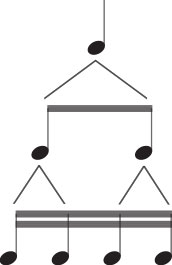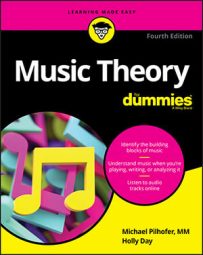- Each beat is divided into two equal components. If a single beat has more than one note, those notes are always grouped together to equal one beat. This characteristic is most obvious when it’s applied to eighth and smaller notes. In simple time, two eighth notes are always connected together with a bar called a beam, as are four sixteenth notes, or eight thirty-second notes. (If you have two sixteenth notes and one eighth note, those three notes, which equal one beat, are also beamed together.) The following figure shows the progression of how notes are beamed together in simple time.
- The note that gets one beat has to be an undotted note. When you’re counting a song out in your head, you’re going to be counting only undotted notes that are divisible by two. Usually this means you’ll be counting quarter notes, but you also may be counting half notes, whole notes, or, sometimes, eighth notes.
In 4/4 time, for example, in your head you’ll be counting, “One-two-three-four” over and over again. In 3/4 time, it’ll be “one-two-three” over and over again; in 2/4 time, “one-two.”
- The top number isn’t divisible by 3 except when it is For example, 3/4 and 3/8 are considered simple time signatures, whereas 6/4, 6/8, and 9/16 aren’t (because they are divisible by 3; these are compound time signatures).
- The number of beats is the same in every measure. Every measure, or bar, of music in a simple time signature has the same number of beats throughout the song. After you get into the groove of counting out the time, you don’t have to worry about doing anything but making sure the notes in the song follow that beat all the way through.
 Each level of this tree equals every other layer, and multiple notes within a beat are always grouped together to equal one beat.
Each level of this tree equals every other layer, and multiple notes within a beat are always grouped together to equal one beat.The following sections explain how to use measures to count in simple time and provide you with some counting practice.
Using measures to count in simple time
Measures (or bars) help performers keep track of where they are in a piece of music and help them play the appropriate beat. In simple time, the measure is where the true rhythm of a piece of music can be felt, even if you’re just reading a piece of sheet music without playing it.In simple time, a slightly stronger accent is placed on the first beat of each measure.
Here are some common examples of simple time signatures (some of which we describe in the following sections):- 4/4: Used in popular, classical, rock, jazz, country, bluegrass, hip-hop, and house music
- 3/4: Used for waltzes and country and western ballads
- 2/4: Used in polkas and marches
- 3/8: Used in waltzes, minuets, and country and western ballads
- 2/2: Used in marches and slow-moving processionals
Counting 4/4 time
When you see a line of music that has a 4/4 time signature like the one in the following figure, the beat is counted off like this:ONE two three four ONE two three four ONE two three four
 A time signature of 4/4 satisfies the requirements of simple time.
A time signature of 4/4 satisfies the requirements of simple time.The bottom number 4 in the time signature in the figure tells you that the quarter note gets the beat, and the top number 4 tells you that each measure contains four beats, or four quarter notes.
Because 4/4 time is so often used in popular types of music, it’s frequently referred to as common time. In fact, instead of writing “4/4” for the time signature, some composers just write a large “C” instead.
Counting 3/4 time
If the time signature of a line of music is 3/4, as in the following figure, the beat is counted like this:ONE two three ONE two three ONE two three
 A time signature of 3/4 satisfies the requirements of simple time.
A time signature of 3/4 satisfies the requirements of simple time.Counting 3/8 time
If the time signature is 3/8, the first note in the measure— whatever it may be — gets a slight stress. In this figure, that first note is an eighth note. A time signature of 3/8 satisfies the requirements of simple time.
A time signature of 3/8 satisfies the requirements of simple time.You count out the beat of the music shown in the figure like this:
ONE two three ONE two three ONE two three
The time signatures 3/8 and 3/4 have almost exactly the same rhythm structure in the way the beat is counted off. However, because 3/8 uses eighth notes instead of quarter notes, the eighth notes get the beat.
Counting 2/2 time
If the time signature of a line is 2/2, also called cut time, the half note gets the beat. And because the top number determines that the measure contains two beats, you know that each measure has two half notes, as shown. In 2/2 time, the half note gets the beat, and each measure contains two beats.
In 2/2 time, the half note gets the beat, and each measure contains two beats.You count the music in the figure like this:
ONE two ONE two
Time signatures with a 2 as the lower number were widely used in medieval and pre-medieval music. Music from this period used a rhythm structure, called a tactus — later called a minim — that was based on the rhythm pattern of a human heartbeat.
Practicing counting beats in simple time
Using the information from the preceding sections, practice counting out the beats (not the notes) shown in the following series of figures. When counting these beats out loud, remember to give the first beat a slight stress. For a challenge, try tapping out the notes while you count the beats out loud.Exercise 1
ONE two three four | ONE two three four | ONE two three four
 Exercise 1.
Exercise 1.Exercise 2
ONE two three | ONE two three | ONE two three
 Exercise 2.
Exercise 2.Exercise 3
ONE two three | ONE two three | ONE two three
 Exercise 3.
Exercise 3.Exercise 4
ONE two three | ONE two three | ONE two three
 Exercise 4.
Exercise 4.Exercise 5
ONE two | ONE two | ONE two
 Exercise 5.
Exercise 5.
